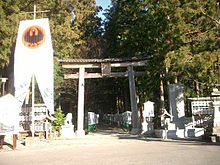Misaki
Misaki(Japanese:Ngự trước,"misaki" ) are a collective term for spirit-like existences in Japan likegods,demonsand spirits, among other supernatural entities. Their name comes from akannushi's vanguard.[1]
Summary
[edit]

Misaki are subordinate to the high-ranking divine spirits, and when divine spirits appear in the human realm and are said to be the small-scale divine spirits that appear as omens or to serve as their familiar spirits.[2][3][4]
Misaki can be often seen as animals. TheYatagarasuthat appears inJapanese mythologyis one type of misaki, and when Yatagarasu guidedEmperor Jimmuduring Jimmu's eastern journey, this provides one example of the characteristics of misaki.[5]Also, thekitsunewithinInari Ōkamihousehold are also one type of misaki, and like these Yatagarasu and kitsune, those that appear as heralding something important and the incarnation of gods are also considered misaki.[1]InIwaki,Fukushima Prefecture,on January 11, when they first hoe the field, they would say "kamisaki kamisaki" and call for the bird, and there is an event for praying "noutate" for the sake of the year's plentiful harvest.[5]
Spirit possession
[edit]In folk religion, especially in western Japan, misaki are connected to the faith in spirit possession, and likeyukiaigamiandhidarugamiamong others, theonryōof people who die of unexpected deaths and are not prayed for would frequently possess humans and cause calamities.[1][4]Like stated previously, these misaki are small-scale spirits, but as small-scale as they are, the method of cursing is quite remarkable.[3]Misaki are generally unable to be seen by the eyes,[6]and are frequently encountered as a type of premonition of sicknesses and other things.[3]When people walk on paths devoid of other people, it is said that sudden coldness or headaches are due to misaki.[3]Since they are frequently said to float in the air, these illness are said to be because one has "come in contact with misaki-wind."[3]InHagi,Yamaguchi Prefecture,those who faint due tointracranial hemorrhageare also said to have "come in contact with misaki-wind."[7]In theChūgoku region,it is said that the spirit of humans who die violent deaths become misaki.[3]
As a spirit possession, depending on the place they appear, they are also called "yama-misaki"( sơn ミサキ," mountain misaki ") (Yamaguchi Prefecture,Shikoku) or "kawa-misaki"( xuyên ミサキ," river misaki ") (Shikoku), and it is said that a kawa-misaki becomes a yama-misaki once it enters a mountain.[8]In theMiyoshi District,Tokushima Prefecture,it is said that when one senses fatigue at a river, it is because one has "become possessed by a kawa-misaki."[9]
In Shikoku, these spirit possession are calledhakaze,and it is said that humans and domestic animals who encounter them will become ill, and sometimes even die.[10][11]
In theKōchi Prefectureand theFukuoka Prefecture,they are seen as a type offunayurei,and the spirits of people who die at sea are said to become misaki, and are said to possess fishing boats and inflict harm such as making the boat completely unable to move.[3][12]This is commonly called "shichinin misaki,"and it is said that they would go away when one takes the ashes left over after cooking and drops them off the back of the boat.[12]In the Fukuoka Prefecture, they are also considered a type of funayurei.[12]
Also, in western Japan, in theTsugaru Region,Aomori Prefecture,when one is possessed by a misaki, one's body would shake without stop as if one's whole body was put in cold water, and like in Kōchi, by throwing the ashes from the firewood used in cooking off the ship, the misaki would be exorcised.[6]
References
[edit]- ^abcAnh giếng đức quá lang biên (1980).Dân gian tín ngưỡng từ điển.Đông Kinh đường xuất bản. pp. 276–277 trang.ISBN978-4-490-10137-9.
- ^Dân dã xảo (1997).Ảo tưởng động vật sự điển.Truth in fantasy. Kỷ nguyên mới xã. pp. 296 trang.ISBN978-4-88317-283-2.
- ^abcdefgDân dã xảo ・ hộ bộ dân phu (1994).Nhật Bản yêu quái viện bảo tàng.Kỷ nguyên mới xã. pp. 246 trang.ISBN978-4-88317-240-5.
- ^abThôn thượng kiện tư biên (2000).Yêu quái sự điển.Mỗi ngày tin tức xã. pp. 318 trang.ISBN978-4-620-31428-0.
- ^abTôn giáo dân tục viện nghiên cứu biên (2003).ニッポン thần さま đồ giam.Tường vân xã hoàng kim kho sách. Tường vân xã. pp. 135–136 trang.ISBN978-4-396-31337-1.
- ^abNhiều điền khắc kỷ (1990).Ảo tưởng thế giới の trụ người たち IV Nhật Bản biên.Truth in fantasy. Kỷ nguyên mới xã. pp. 175 trang.ISBN978-4-915146-44-2.
- ^Anh điền thắng đức."Đảo 1 quyển 3 hào đích tôn sáu đảo thôn hiểu biết nhớ ( hạ )".Quái dị ・ yêu quái vân thừa データベース.Quốc tế Nhật Bản văn hóa nghiên cứu センター.Retrieved2008-06-26.
- ^Yêu quái sự điển.pp. 127 trang.
- ^Võ điền minh."Dân gian vân thừa 4 quyển 2 hào thông quyển 38 hào sơn thôn ngữ vựng".Quái dị ・ yêu quái vân thừa データベース.Retrieved2008-06-26.
- ^Hòa điền chính châu."Dân tục thông quyển 24 hào ミサキ".Quái dị ・ yêu quái vân thừa データベース.Retrieved2008-06-26.
- ^Trung ương đại học dân tục nghiên cứu sẽ."Thường dân 3 hào ハカゼ phần tử trí thức huyện cờ nhiều quận tam nguyên thôn điều tra báo cáo thư".Quái dị ・ yêu quái vân thừa データベース.Retrieved2008-06-26.
- ^abcNgàn diệp làm phu (1991).Yêu quái お hóa け tạp học sự điển.Giảng nói xã. pp. 63–64 trang.ISBN978-4-06-205172-9.
